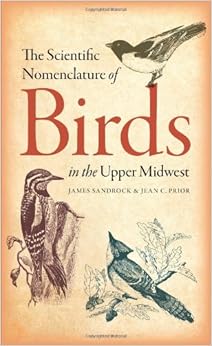The Scientific Nomenclature of Birds of the Midwest
I first heard about this book while looking through the upcoming books section on Buteo Books website. It sounded interesting and when I noticed that it was published by the Iowa Press (support your local publishers!) it jumped to the front of my wishlist.
This small reference title explains the history, science, and reasoning behinds the names of 450 birds of the upper midwest (from the Dakotas to Ohio and down to Missouri and Kansas).
When I first started flipping through the book finding different birds I found myself a bit frustrated that the book is organized alphabetically by genus as opposed to following a typical field guide layout according to taxonomy. Since I am not at all fluent in the scientific names of birds, I found that whenever I wanted to look up a bird, I had to first find it's scientific name. However, a week later, I am realizing that having the book organized this way is slowly making me learn the scientific names of some of the birds which has been a goal of mine for some time now.
Although I've only had the book a short time I've noticed a couple of things. First, the naming of birds pretty much falls into a handful of categories:
- Named for ornithologists, other naturalists, or their patrons: Larus thayeri (Thayer's Gull); Larus - Latin for " voracious seabird, gull"; thayeri - Named for John Eliot Thayer, a supporter of many ornithological expeditions.
- Their appearance: Tyrannus forficatus (Scissor-tailed Flycatcher); Tyrannus - Latin for "tyrant, despotic ruler, etc..). This genus includes all the Kingbirds; forficatus - Latin for "having the nature of scissors/shears".
- Where they were collected: Cistothorus platensis (Sedge Wren); Cistothorus - From the Greek Kistos=Shrub and Thorus=Leaper which certainly describes both the Sedge and Marsh Wrens; platensis - Coined Latin for "Of the Rio de la Plata" near Buenos Aires, where the specimen was collected.
Second, I've learned that some birds scientific names are a source of mystery or of unknown origin while others maker little sense or add confusion.
And finally, the authors note how DNA testing is constantly changing the way we classify birds which means that some birds might get moved to a different genus or get placed in a brand new one all by themselves, but they will always keep the same species designation.
I highly recommend this book for anyone with in interest in bird names or the history of ornithology.

No comments:
Post a Comment